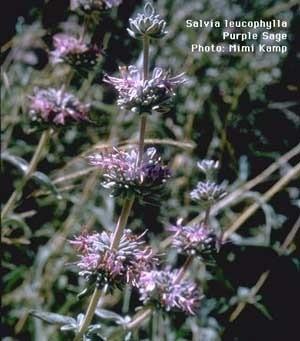
Here are the questions asked by community members. Read on to see the answers provided by the ThriftyFun community.
Hardiness Zone: 5b
Joyce from Wis
The purple flowers are what you want to see-a great sign! It isn't unusual for the common varieties of sage plants to skip flowering the first year after being planted. There are also perennial species of sage, like Clary sage (S. sclarea) that don't bloom until the second year. More than likely, your sage was just focusing all of its energy on putting down healthy roots and becoming established. The fact that it has flowered this year indicates that it is healthy, happy, and right at home in its new environment.
To keep it that way, keep it watered consistently (but don't over water), provide it with good air circulation, and pinch it back several inches at least once during the growing season. Pinching it back will encourage young shoots and prevent your sage from getting tall and leggy.
You can use sage fresh or dried. To air-dry bundles of leaves and stems, hang them upside down or lay them out on racks. Chop up fresh leaves and place them in ice cube trays with water to freeze and use later. (This is a handy way to add sage to soups and stews).
Have fun!
Ellen
You may have cut it back too early last year and missed the bloom. I grow sage for the leaves AND the pretty flowers for my kitchen table. Enjoy!
Same thing happened with mine. It is just about to bloom right now. I guess it is time for it to reseed. Seems early though.
I have sage plants also, and they bloom purple too. This is common for this plant. Since it is a perennial it might not have been old enough for it to bloom the first year. A lot of perennial plants do not bloom the first year.
My sage is about 2 years old (or maybe even three) and has blooms for the first time right now. They are purple and much taller than the rest of the greenery.
I do absolutely NOTHING to my two. One still lives in a badly broken 10 gallon clay pot totally covered in a Poly/Cotton pillowcase, never gets food. Why? Because they require almost no care and still bloom. There are several varieties, so try to find out. I've espaliered mine twice while in the pots, but moved them one time years ago and haven't gotten around to planting them in ground, but they still bloom their leaves out.
God bless you. : )

By Deeli from Richland, WA
I grow sage away from the house. When wet it does smell unpleasant, but it's so useful and if left to flower the bees love it. I dry the leaves for the winter and leave the plant in the ground. It gets huge!
Marg from England.
I guess I would suspect what you smell is correct.
My sage does not smell/stink.
Cats left outside do considerable damage to people's flower beds, gardens, edibles. Their urine smell in the soil is strong and the up sweep through the root system can make your plants smell/taste? funny.
I try my best to have a cat free yard, trusty garden hose discourages those who are turned out by their owners to do the damage. My dog is tethered within the confines of my yard and discourages them and the squirrels when she is out.
(We don't have dog spots in the yard as some people's yards showcase. If your dog has plenty of fresh water several times a day, their urine/feces will not harm the grass. Especially in our heat waves, it is so important for the dogs to drink a lot more.)
Marg, thanks so much for letting me know I am not crazy ;-)
T&T Grandma, it's in a pot on a wood balcony rail ledge that is so so crowded with plants that no cat could get up there to spray it, but I do know what you mean about cats leaving those smells in the garden ;-)
My sage plant looks fine and is growing nicely but older leaves turn kind of yellow. Is this "normal"? Can these leaves be dried and used for tea?
Mellow Yellow,
Hey I am not sure about the yellow leaves, but I thought I would let you know to be careful about Sage Tea. Sage causes your body to not sweat. Great if you are having night sweats or hot flashes or any sweating too much problems. However if you work out or are going to spend time in the heat or sun it is imparative that you be able to sweat as it is your bodies cooling system. So, bottom line is: go easy on the Sage tea and look out for this problem if you drink it--get hot--and notice you are not sweating. Then you must cool yourself down immediately!
Best,
Felicia
I'm doing some research about black and white sage right now for an ecology paper. I'm not sure what causes it yet, but I did a chlorophyll test on black sage from 2 different locations one had no yellowing of the leaves and the other did. The plants that had yellowing had a lower chlorophyll measurement, it may or may not effect the quality of the tea being made. Just thought I would throw that in there. Much Love. -Crystal